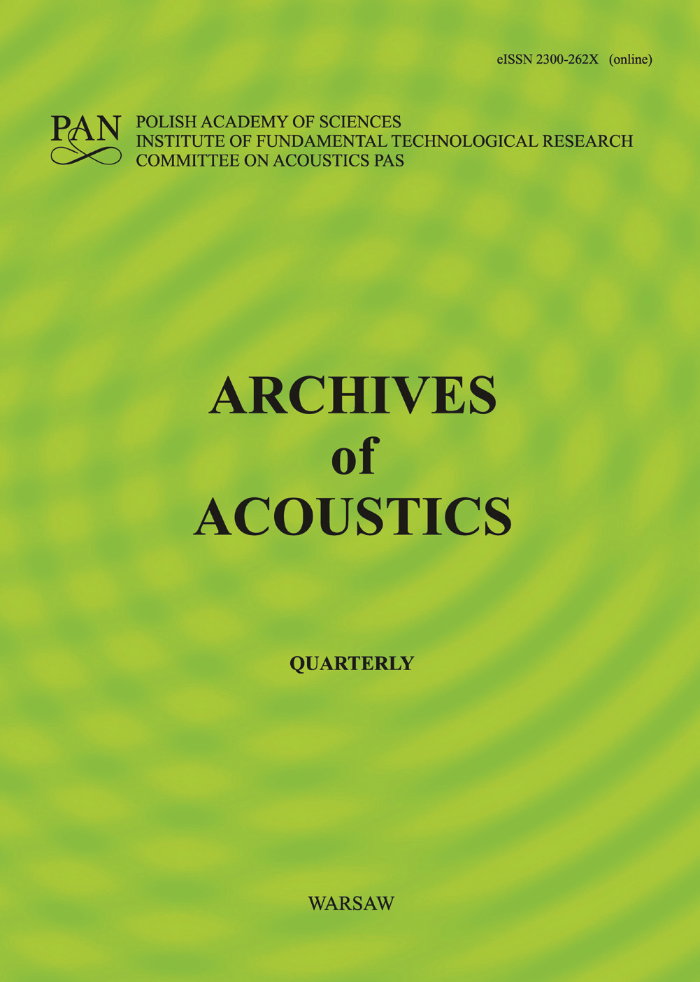Abstract
Good speech intelligibility in university classrooms is crucial to the learning process, ensuring that students can clearly hear all conversations taking place in the classroom. While it is well known that speech intelligibility depends on the geometrical characteristics of a space and the properties of its surfaces, other factors need also to be considered. Among the most important are: the heating, ventilation, and air conditioning (HVAC) systems used in classrooms. Fan noise from HVAC systems increases the background noise level (BNL), negatively affecting speech intelligibility. In addition, the movement of air caused by these systems alters room acoustic variables. Although this dynamic situation is often overlooked in the early design stages, HVAC systems are often active during lectures and influence acoustics variables, especially the speech transmission index (STI). In this study, the impact of HVAC systems on the STI was measured in five different unoccupied classrooms in the Rafet Kayıș Faculty of Engineering at Alanya Alaaddin Keykubat University. The results were evaluated according to relevant standards. The results of these evaluations offer insights for researchers, architects, and engineers working in the field of acoustics.Keywords:
speech intelligibility, speech transmission index (STI), room acoustic variables, room impulse response (RIR), acoustic performanceReferences
- American National Standard (2010), Acoustical performance criteria, design requirements, and guidelines for schools, Part 1: Permanent Schools (ANSI/ASA S12.60-2010/Part 1), https://webstore.ansi.org/standards/asa/ansiasas1260part2010r2020?source=blog. (access: 15.07.2024).
- Antoniadou S., Papadakis N.M., Stavroulakis G.E. (2018), Measuring acoustic parameters with ESS and MLS methods: Effect of artificially varying background noise, [in:] Euronoise 2018 – Conference Proceedings, https://www.euronoise2018.eu/docs/papers/132. Euronoise2018.pdf (access: 22.07.2024).
- Astolfi A., Bottalico P., Barbato G. (2012), Subjective and objective speech intelligibility investigations in primary school classrooms, The Journal of the Acoustical Society of America, 131(1): 247–257, https://doi.org/10.1121/1.3662060.
- Building Bulletin (2015), BB93: Acoustic design of schools – Performance standards, Department for Education, Education Funding Agency, England, https://assets.publishing.service.gov.uk/media/5a8170d3e5274a2e8ab54012/BB93. February 2015.pdf (access: 14.08.2024).
- Choi Y.-J. (2020), Evaluation of acoustical conditions for speech communication in active university classrooms, Applied Acoustics, 159: 107089, https://doi.org/10.1016/j.apacoust.2019.107089.
- Cushing I.R., Li F.F., Cox T.J., Worrall K., Jackson T. (2011), Vocal effort levels in anechoic conditions, Applied Acoustics, 72(9): 695–701, https://doi.org/10.1016/j.apacoust.2011.02.011.
- Di Loreto S., Cantarini M., Squartini S., Lori V., Serpilli F., Di Perna C. (2023), Assessment of speech intelligibility in scholar classrooms by measurements and prediction methods, Building Acoustics, 30(2): 165–202, https://doi.org/10.1177/1351010X231158190.
- Elliott T.M., Theunissen F.E. (2009), The modulation transfer function for speech intelligibility, PLoS Computational Biology, 5(3): e1000302, https://doi.org/10.1371/journal.pcbi.1000302.
- Engel M., Herrmann J., Zannin P. (2020), Assessment of the sound quality of classrooms through speech transmission index (STI), sound definition (D50) and reverberation time (RT), Forum Acusticum.
- Guidorzi P.A., Barbaresi L.U., D’Orazio D.A., Garai M.A. (2015), Impulse responses measured with MLS or Swept-Sine Signals applied to architectural acoustics: An in-depth analysis of the two methods and some case studies of measurements inside theaters, Energy Procedia, 78: 1611–1616, https://doi.org/10.1016/j.egypro.2015.11.236.
- Houtgast T., Steeneken H. J. (1985), A review of the MTF concept in room acoustics and its use for estimating speech intelligibility in auditoria, The Journal of the Acoustical Society of America, 77(3): 1069–1077, https://doi.org/10.1121/1.392224.
- Huang W., Peng J., Xie T. (2023), Study on Chinese speech intelligibility under different low-frequency characteristics of reverberation time using a hybrid method, Archives of Acoustics, 48(2): 151–157, https://doi.org/10.24425/aoa.2023.145229.
- International Organization for Standardization (2003), Ergonomics – Assessment of speech communications (ISO Standard No. 9921:2003), https://www.iso.org/standard/33589.html. (access: 05.09.2024).
- International Organization for Standardization (2009), Acoustics – Measurement of room acoustic parameters – Part 1: Performance spaces (ISO Standard No. 3382-1:2009), https://www.iso.org/standard/40979.html. (access: 05.09.2024).
- International Organization for Standardization (2014), Acoustics – Field measurement of sound insulation in buildings and of building elements – Part 1: Airborne sound insulation (ISO Standard No. 16283-1:2014), https://www.iso.org/standard/55997.html. (access: 05.09.2024).
- International Organization for Standardization (2021), Acoustics – Laboratory measurement of sound insulation of building elements – Part 1: Application rules for specific products (ISO Standard No. 10140-1:2021), https://www.iso.org/standard/73910.html. (access: 05.09.2024).
- International Electrotechnical Commission (2020), Sound system equipment – Part 16: Objective rating of speech intelligibility by speech transmission index (IEC Standard No. 60268-16:2020), https://webstore.iec.ch/en/publication/26771. (access: 20.08.2024).
- Kawata M., Tsuruta-Hamamura M., Hasegawa H. (2023), Assessment of speech transmission index and reverberation time in standardized English as a foreign language test room, Applied Acoustics, 202: 109093, https://doi.org/10.1016/j.apacoust.2022.109093.
- Lochner J.P.A., Burger J.F. (1964), The influence of reflections on auditorium acoustics, Journal of Sound and Vibration, 1(4): 426–454, https://doi.org/10.1016/0022-460X. (64)90057-4.
- Longoni H.C. et al. (2016), Speech transmission index variation due to ventilating and air-conditioning system in university classrooms, [in:] Proceedings of Meetings on Acoustics, 28: 015024, https://doi.org/10.1121/2.0000470.
- Masovic D. (2021), Room acoustics, arXiv, https://doi.org/10.48550/arXiv.2111.01900.
- Mejdi A., Gardner B., Musser C. (2019), Prediction of the speech transmission quality in the presence of background noise using the ray tracing technique, [in:] 26th International Congress on Sound and Vibration (ICSV), https://www.academia.edu/64361351/Prediction. of the Speech Transmission Quality in the Presence of Background Noise Using the Ray Tracing Technique (access: 15.11.2024).
- Meng Q., Sen D.,Wang S., Hayes L. (2008), Impulse response measurement with sine sweeps and amplitude modulation schemes, [in:] 2nd International Conference on Signal Processing and Communication Systems, https://doi.org/10.1109/ICSPCS.2008.4813749.
- Minelli G., Puglisi G.E., Astolfi A. (2022), Acoustical parameters for learning in classroom: A review, Building and Environment, 208: 108582, https://doi.org/10.1016/j.buildenv.2021.108582.
- Murgia S., Webster J., Cutiva L.C.C., Bottalico P. (2023), Systematic review of literature on speech intelligibility and classroom acoustics in elementary schools, Language, Speech, and Hearing Services in Schools, 54(1): 322–335, https://doi.org/10.1044/2022. LSHSS-21-00181.
- Payton K.L., Shrestha M. (2008), Evaluation of short-time speech-based intelligibility metrics, [in:] The 9th International Congress on Noise as a Public Health Problem (ICBEN), https://www.researchgate.net/publication/256579565. (access: 15.11.2024).
- Peutz V.M.A. (1972), Articulation loss of consonants as a criterion for speech transmission in rooms, [in:] Audio Engineering Society Convention 2ce. Audio Engineering Society, https://aes2.org/publications/elibrary-page/?id=1821. (access: 15.11.2024).
- Rabelo A.T.V., Santos J.N., Oliveira R.C., Magalhães M.D.C. (2014), Effect of classroom acousticson the speech intelligibility of students, CoDAS, 26(5): 360–366, https://doi.org/10.1590/2317-1782/20142014026.
- Razali A.W., Din N.B.C., Yahya M.N., Sulaiman R. (2024), Conceptual framework of acoustic comfort design enablers for a classroom: A systematic review, Journal of Building Engineering, 95: 110160, https://doi.org/10.1016/j.jobe.2024.110160. 3
- Rossing T.D. [Ed.] (2014), Springer Handbook of Acoustics, 2nd ed., Springer, Germany.
- Yang D., Mak C.M. (2018), An investigation of speech intelligibility for second language students in classrooms, Applied Acoustics, 134: 54–59, https://doi.org/10.1016/j.apacoust.2018.01.003.
- Zhu P., Tao W., Mo F., Lu X., Zhang H. (2024), Experimental comparisons of speech transmission index prediction methods, Applied Acoustics, 220: 109985, https://doi.org/10.1016/j.apacoust.2024.109985.







